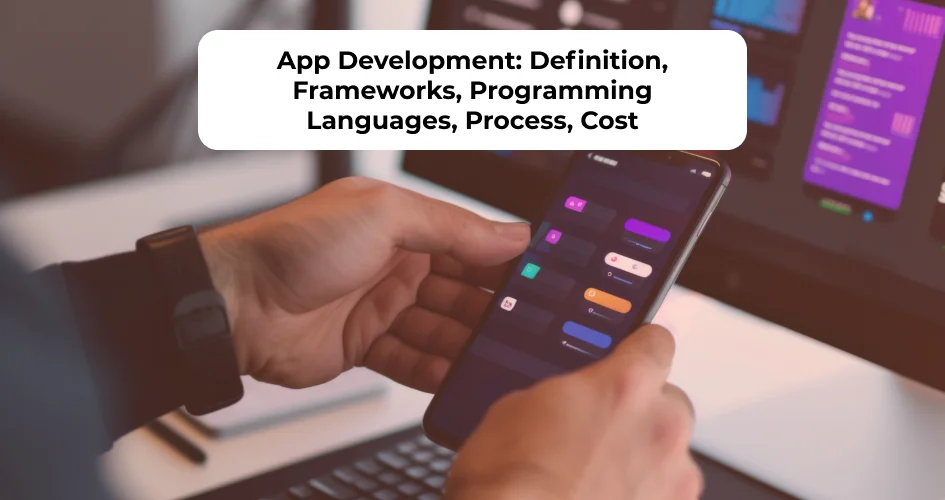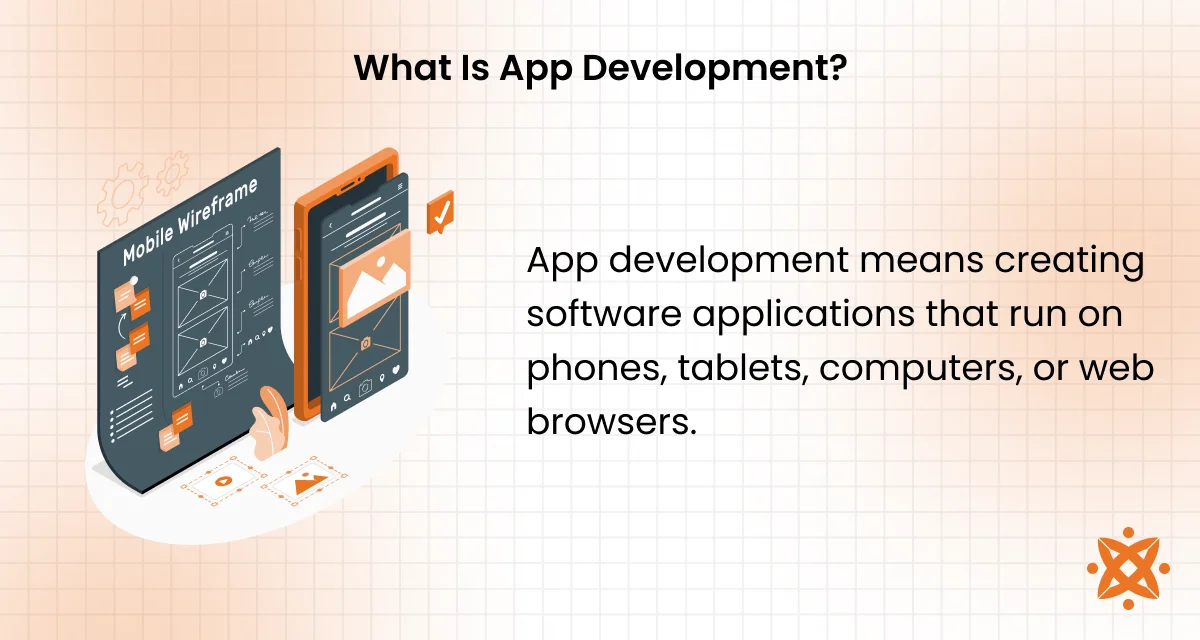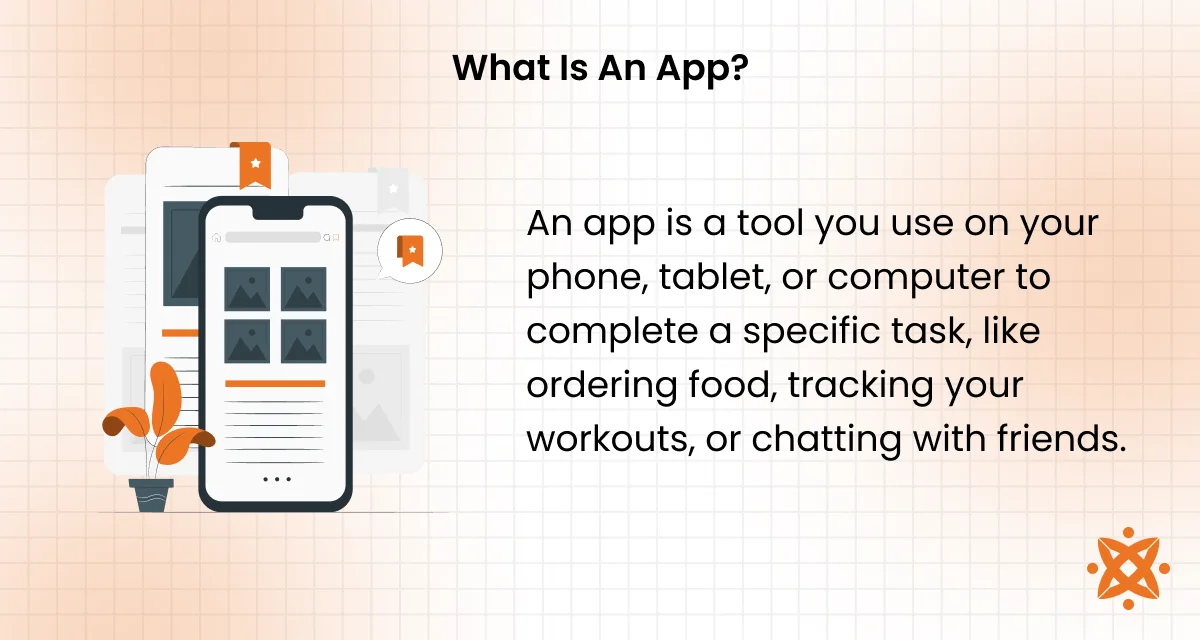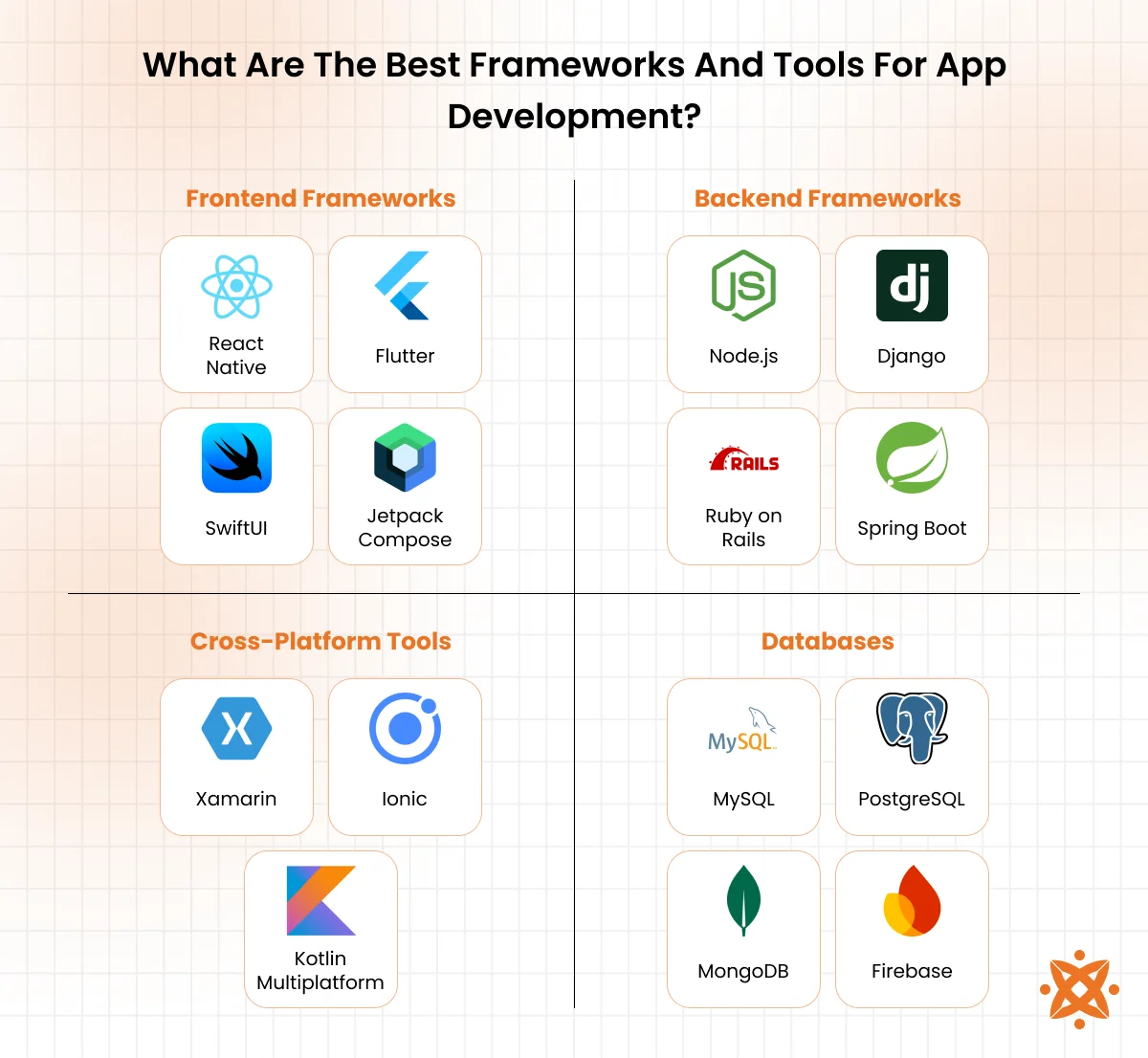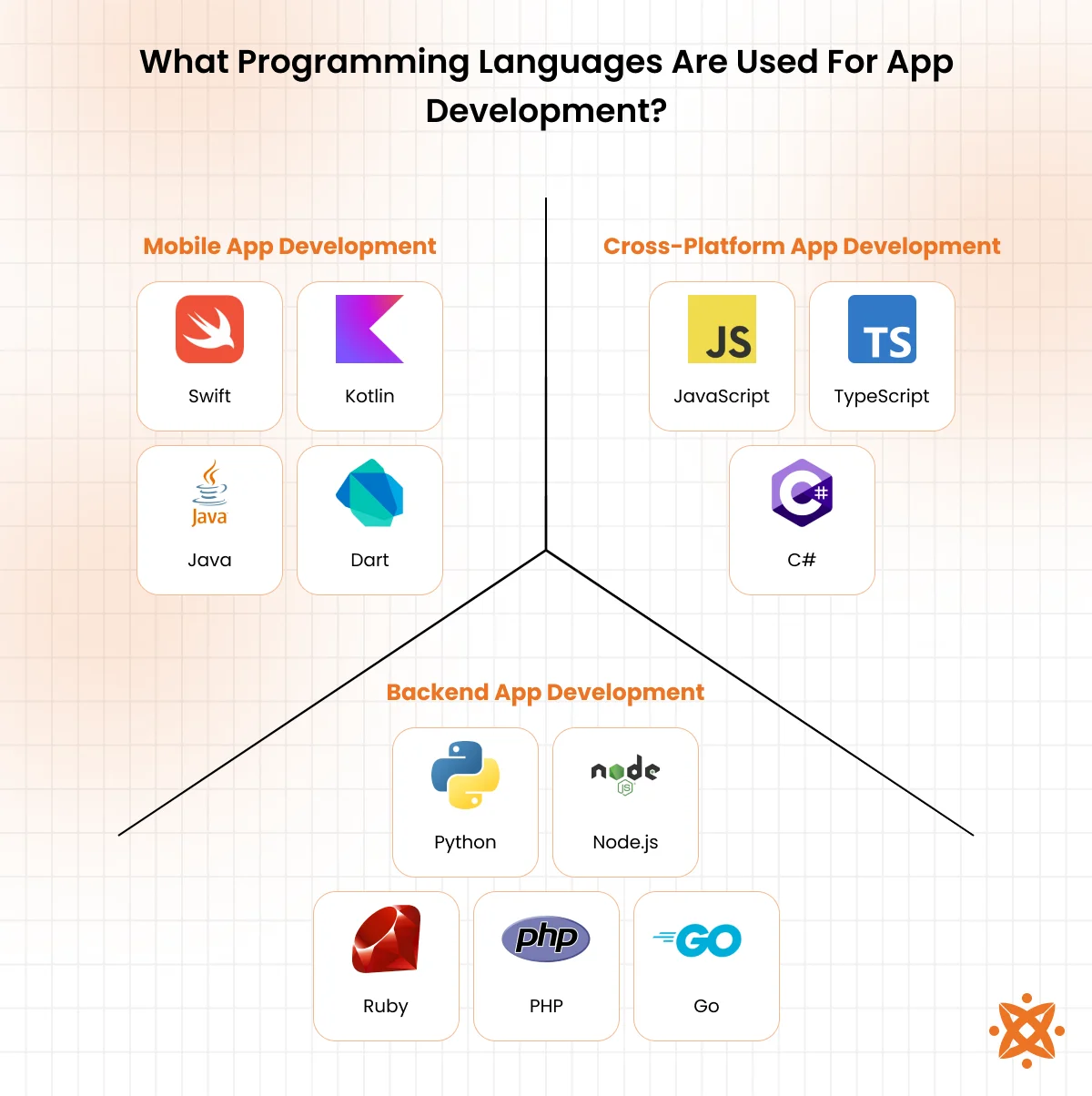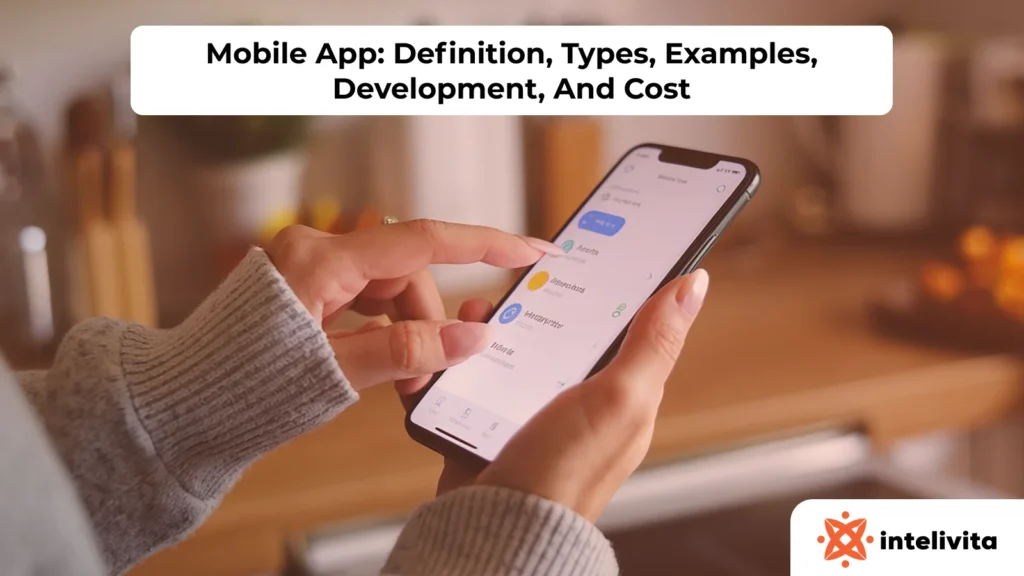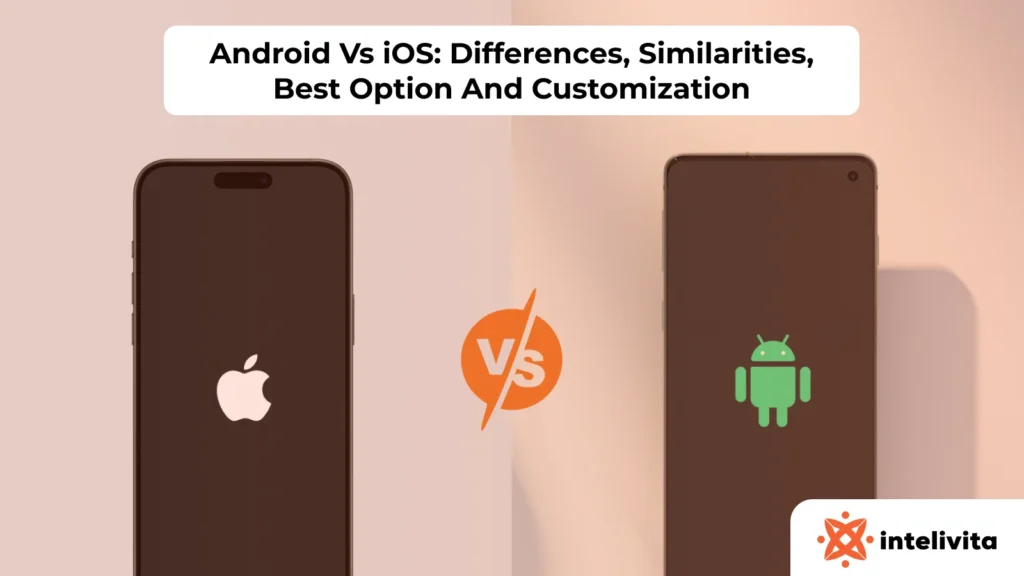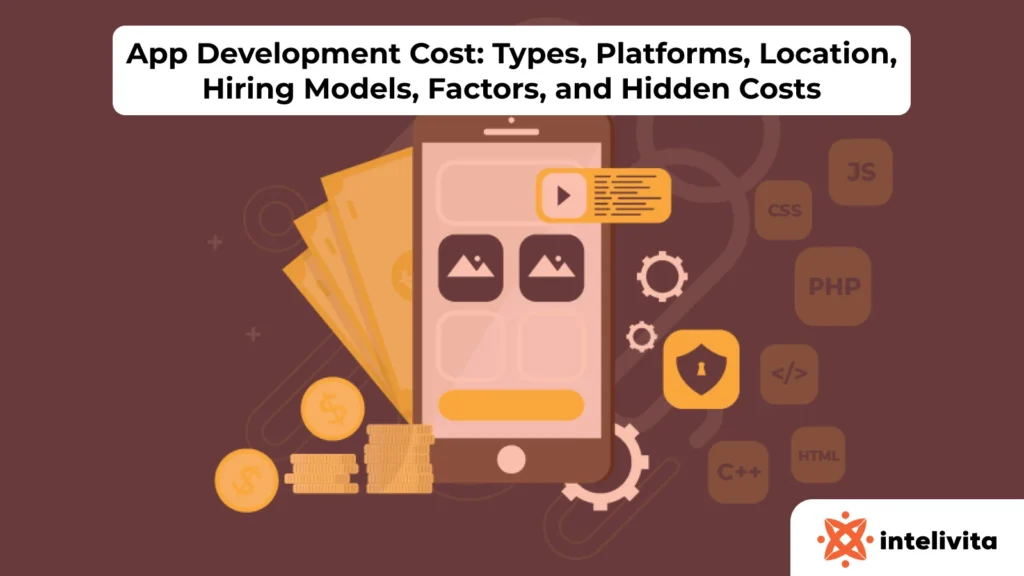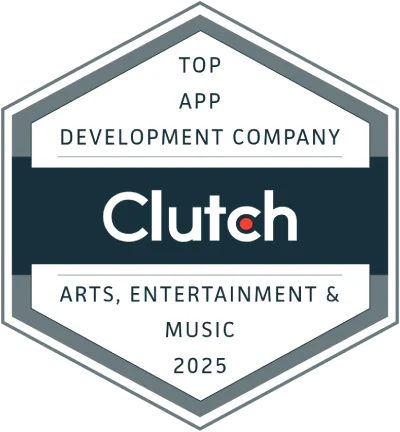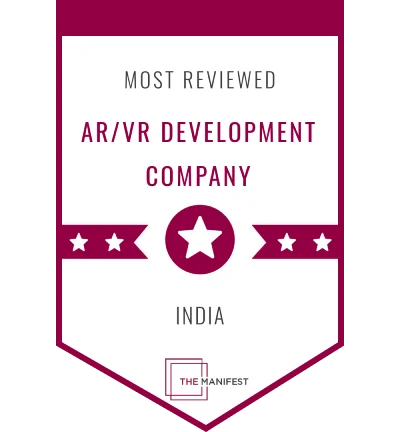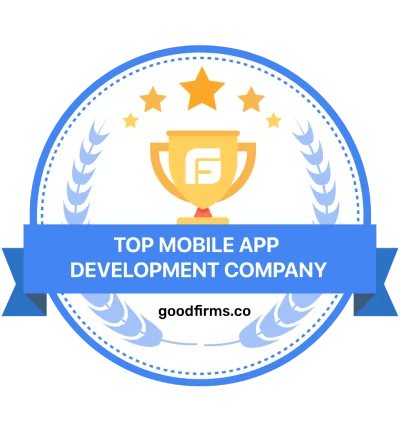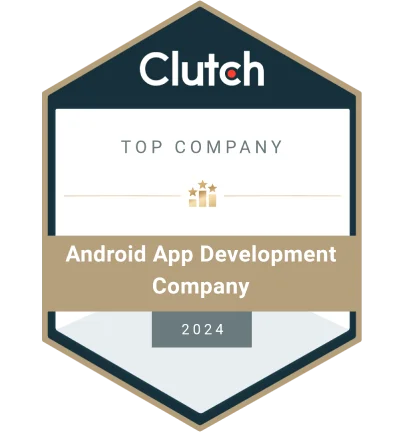App development combines frontend and backend technologies, user-centered design, and device-specific features to deliver smooth digital experiences. Whether you’re creating a finance tracker, food delivery service, or social platform, apps are built to support real-time interaction, automation, and personalized content.
The different types of mobile apps are iOS apps, Android OS apps, web apps, native apps, hybrid apps, and cross-platform apps. Each type is built differently and works best in specific situations based on the device, performance needs, and user experience.
The best frameworks and tools for app development are frontend app development frameworks, backend app development frameworks, cross-platform app development tools, and app development databases. Each one plays a different role, from designing the interface to managing data and server operations.
The programming languages used in app development are grouped into mobile app development, cross-platform app development, and backend app development. Each set supports a different part of the app development process, from interface to logic.
To develop an app, the processes involved are planning the features, setting up the development environment, designing the user interface, writing the code, testing it on devices, and publishing it on platforms like the App Store or Google Play. The steps vary slightly by platform, such as iOS App Development, Android App Development, or Web Development. But the structure remains the same.
It costs an average of $10,000 to $18,000 to build a fully functional mobile app. Simple apps with limited screens and no backend integration fall at the lower end. More complex apps, with real-time updates, custom user interfaces, secure authentication, and cloud computing for apps, exceed $18,000.
According to a study by Clutch titled “2022 App Development Survey,” 2022, 48% of businesses spent over $100,000 on custom app development, with timelines ranging from 3 to 9 months.
What Is App Development?
App development means creating software applications that run on phones, tablets, computers, or web browsers. You use these apps to do things like shop online, book a ride, chat with friends, or manage money.
Developers write the code, design the user interface, and test everything before it’s ready for people to use. Apps are downloaded from app stores or utilized right in your browser.
You need app development to bring digital ideas to life and solve problems in real time. You rely on apps to check your bank balance, track workouts, order groceries, and connect with people. Businesses use apps to reach more users, automate tasks, and increase revenue.
Health, education, finance, entertainment, every industry uses apps to give you better, faster, and more personal services.
What Is An App?
An app is a tool you use on your phone, tablet, or computer to complete a specific task, like ordering food, tracking your workouts, or chatting with friends. It responds to your actions, connects to servers when needed, and delivers information or services directly to your screen.
Every app works through a basic architecture that includes a user interface, frontend, and backend. The user interface is what you see and touch. The frontend handles what happens on your device, and the backend processes data on a remote server. These parts work together to give you a smooth experience.
You benefit from mobile apps because they are faster, more convenient, and designed for specific actions. They allow you to access services directly, use built-in phone features like GPS or camera, and even function without the internet in some cases. Businesses also gain better customer connections and data collection through apps.
What Are The Different Types Of Mobile Apps?
The different types of mobile apps are iOS apps, Android OS apps, web apps, native apps, hybrid apps, and cross-platform apps. You use these apps every day, whether you’re checking your email, browsing a store, or using maps.
The different types of mobile apps are explained below:
iOS Apps
iOS apps are the ones you download and use on your iPhone or iPad. You use them to do everything from listening to music to checking your bank account. These apps are built using Apple’s tools and follow strict design rules that make them smooth, fast, and easy to navigate.
iOS apps use Swift or Objective-C programming languages and are created in Xcode, Apple’s official development environment. Key features include high performance, secure data handling, and smooth integration with iOS features like Face ID, Siri, and Apple Pay. Updates and downloads happen through the App Store, giving you access to verified, stable apps with a consistent user experience.
Android Os Apps
Android OS apps are the ones you install on phones and tablets that run on the Android system, like Samsung, Pixel, or Motorola devices. You use them for browsing, shopping, watching videos, or handling work tasks. These apps are built using Google’s tools and give you more flexibility in how you use and customize them.
Android OS apps are developed with Java or Kotlin in Android Studio and often rely on open-source components. Key features include deep device customization, wide hardware support, and access to Google services like Maps, Assistant, and Gmail. You download them through the Google Play Store or other app stores, and many offer settings you adjust to fit your preferences.
Web Apps
Web apps are the kind of apps you open in your browser without installing anything on your device. You use them to check emails, read news, manage tasks, or even shop online. They load on websites but feel and act like mobile apps, giving you tools and services without taking up storage space.
Web apps run using web technologies like HTML, CSS, and JavaScript. They work across different devices and adjust to your screen size, whether you’re on a phone or a laptop. Key features include quick updates, no need for downloads, and compatibility with most browsers. While they don’t access your device’s hardware like native apps, they’re great for lightweight, on-the-go tasks.
Native Apps
Native apps are the ones you install directly from an app store and use on one specific type of device, like an iPhone or an Android phone. You use them for everything from gaming to banking, and they’re built to match your device’s look and feel exactly.
Native apps are written in the programming language meant for a single platform — Swift for iOS or Kotlin for Android. This gives you better performance, faster load times, and access to features like camera, push notifications, and GPS. They also work offline more reliably and respond quickly because they interact directly with the device’s operating system.
Hybrid Apps
Hybrid apps are the kind you download like a regular app, but most of what you see and use inside them is powered by web technology. You interact with them just like any other mobile app, but behind the scenes, they run using a mix of web and native code.
Hybrid apps are built using frameworks like Ionic or Apache Cordova, combining HTML, CSS, and JavaScript inside a native wrapper. This lets you access device features while using the same code across platforms. Key features include faster development, lower cost, and the ability to run on both iOS and Android. While performance is slightly lower than native apps, hybrid apps are ideal when you want to reach more users quickly.
Cross-Platform Apps
Cross-platform apps are built to work on both Android and iOS using the same source code. You open one app, but behind it is a single codebase that runs across different devices. This saves you time and effort while keeping the experience nearly the same for all users.
Cross-platform apps use tools like React Native, Flutter, or Xamarin. These frameworks allow developers to write code once and deploy it everywhere. Key features include shorter development cycles, consistent design across platforms, and easier updates. While performance might not match native apps in every case, cross-platform apps are practical for reaching a wider audience without building separate versions.
What Are The Best Frameworks And Tools For App Development?
The best frameworks and tools for app development are frontend app development frameworks, backend app development frameworks, cross-platform app development tools, and app development databases. You use these tools to build, test, and launch apps that run smoothly and deliver real value.
Frontend App Development Frameworks
The frontend app development frameworks include React Native, Flutter, SwiftUI, and Jetpack Compose. You rely on these tools to create the screens, buttons, and layouts you interact with inside an app.
The frontend app development frameworks are:
React Native
React Native lets you build mobile apps using the same ideas and tools used for building websites. You use it to create the app’s visual layout, how it behaves, and how it connects with phone features, all with a focus on simplicity and speed.
It was developed by Facebook and released in 2015. The goal was to make app development faster by reusing code across platforms. You write apps using JavaScript or TypeScript, and the framework turns that code into native app components. Yes, React Native supports cross-platform app development. You write once, and it runs on both Android and iOS, with native performance and real-time updates.
You’ll find it easy to use if you already know web development. It uses common web coding patterns and tools. To use it, you need Node.js, npm, a code editor like VS Code, and a mobile emulator or device for testing.
Flutter
Flutter is a toolkit you use to build mobile apps with rich visuals and smooth motion. You create apps that look and feel like they belong on any device, but without building them twice. It was created by Google and first launched in 2017. It gained attention for its focus on design and fast performance. You write Flutter apps using the Dart programming language, also developed by Google.
Yes, Flutter supports cross-platform app development. You write one codebase that works on both Android and iOS, with native-level speed and appearance. It’s simple to learn, especially if you’re familiar with object-oriented programming. The layout system is clear, and the UI elements are customizable.
To start, you need Flutter SDK, Dart SDK, an editor like Android Studio or VS Code, and an emulator or real device for testing.
SwiftUI
SwiftUI is the tool you use to build app interfaces for Apple devices. It lets you design the app’s layout and behavior using a simple, code-based approach that shows instant visual results. Apple introduced SwiftUI in 2019 as a modern alternative to older UI frameworks like UIKit. It uses the Swift programming language, which is designed for speed and safety.
SwiftUI does not support cross-platform app development beyond the Apple ecosystem. You use it to build apps for iOS, iPadOS, macOS, watchOS, and tvOS, but not for Android or web.
It’s easy to pick up if you already use Swift. The syntax is clear, and its live preview helps you see changes right away. To use it, you need Xcode, Apple’s official development tool, and a Mac to run the software.
Jetpack Compose
Jetpack Compose is how you build modern Android app interfaces with less code and more flexibility. You describe the UI in code, and it updates automatically when your data changes.
Google released Jetpack Compose in 2020 as a new way to build UIs without relying on XML layouts. It uses the Kotlin programming language, which is now the preferred language for Android development.
Jetpack Compose does not support full cross-platform app development, but it integrates with Kotlin Multiplatform, which shares logic across platforms while keeping the UI native to Android.
It’s beginner-friendly if you already know Kotlin. The layout is built using simple functions, and the framework takes care of updates and state changes. To start, you need Android Studio, the Kotlin plugin, and an Android device or emulator for testing.
Backend App Development Frameworks
The backend app development frameworks include Node.js, Django, Ruby on Rails, and Spring Boot. You depend on these tools to handle what happens behind the scenes in your app, like saving user data, processing payments, or managing logins.
The backend app development frameworks are explained below:
Node.Js
Node.js lets you build the backend of an app using JavaScript, the same language you use for frontend web development. It runs code on the server side, handling things like user requests, database actions, and app logic.
It was introduced in 2009 by Ryan Dahl and quickly gained traction for its speed and ability to handle many connections at once. Node.js uses JavaScript, making it easier for developers to work across the frontend and backend with one language.
Node.js supports cross-platform development for backend services. You run it on Windows, macOS, or Linux, and build APIs for apps on any platform.
It’s easy to learn if you already use JavaScript. Its package manager, npm, gives you access to thousands of useful tools. To get started, you need Node.js, npm, a code editor like VS Code, and tools like Express for building web servers.
Django
Django is a backend framework you use to build fast, secure, and organized web applications. It handles database operations, user authentication, and server-side logic so your app runs smoothly and safely.
It was released in 2005 by a team of developers at the Lawrence Journal-World newspaper. They created it to build content-driven websites faster and with fewer errors. Django uses Python, a language known for its clean syntax and wide use in both web and data projects.
Django supports backend development for apps on multiple platforms. While it’s not used for mobile UIs, you connect it to any frontend or mobile app using APIs.
You’ll find it clear to work with if you know Python. It follows strict rules that help you avoid mistakes and move faster. To start, you need Python, Django, a text editor like VS Code, and a database engine such as PostgreSQL or SQLite.
Ruby On Rails
Ruby on Rails helps you build backend systems that manage everything from storing data to handling user sessions. You use it to create full-featured web applications quickly, with less code and more built-in functions.
It was released in 2004 by David Heinemeier Hansson and became known for its fast development cycle. Ruby on Rails uses the Ruby programming language, which focuses on clarity and productivity. Ruby on Rails supports backend services for cross-platform apps, allowing mobile or web front ends to connect through APIs.
It’s direct to use if you’re comfortable with Ruby. The framework handles a lot of the setup work for you and includes tools to speed up tasks like routing and database management.
To begin, you need Ruby, Rails, a code editor like VS Code, and a database system such as PostgreSQL or MySQL.
Spring Boot
Spring Boot is a backend framework that helps you create web services and APIs for complex applications. You use it to power the logic, data processing, and communication that happen behind your app’s interface.
It was launched in 2014 by the Spring team at Pivotal to reduce the time and effort needed to set up Java-based projects. Spring Boot uses Java, one of the most widely used languages for enterprise-level software. Spring Boot supports backend development for cross-platform apps. It connects with any frontend or mobile platform through standard APIs.
You’ll find it structured and organized if you’ve worked with Java. It automates many steps, so you write less setup code and focus more on features. To get started, you need Java Development Kit (JDK), Spring Boot CLI or Spring Initializr, a text editor or IDE like IntelliJ, and a database engine such as MySQL or PostgreSQL.
Cross-Platform App Development Tools
The cross-platform app development tools include Xamarin, Ionic, and Kotlin Multiplatform. You use these tools to write a codebase that works on both Android and iOS.
The cross-platform app development tools are:
Xamarin
Xamarin lets you build mobile apps for Android and iOS using one codebase. You write the app logic once and connect it to native features on each platform.
It was founded in 2011 by engineers from the Mono project and was later acquired by Microsoft in 2016. Xamarin uses C# and the .NET framework, which are known for stability and broad support. Xamarin supports full cross-platform app development, allowing you to reuse up to 90% of your code across platforms.
You’ll work smoothly with it if you’re familiar with C#. It gives you access to native APIs while keeping your code organized. To use Xamarin, you need Visual Studio, .NET SDK, and a mobile emulator or test device.
Ionic
Ionic helps you build mobile apps using web technologies. You create the app layout and behavior using code you normally write for websites, and then run it like a native app on your phone.
It was launched in 2013 by Max Lynch, Ben Sperry, and Adam Bradley of Drifty Co. Ionic uses HTML, CSS, and JavaScript, often with Angular, React, or Vue frameworks.
Ionic supports full cross-platform app development, letting you build for Android, iOS, and the web using a single codebase.
You’ll find it practical if you already know web development. It keeps your workflow similar to building a website, but adds mobile features. To begin, you need Node.js, Ionic CLI, a code editor like VS Code, and a mobile emulator or test device.
Kotlin Multiplatform
Kotlin Multiplatform lets you share code across Android, iOS, web, and desktop apps. You write the core logic once and connect it to each platform’s interface separately.
It was introduced by JetBrains, the creators of Kotlin, and became part of the official Kotlin release roadmap in 2017. Kotlin Multiplatform uses Kotlin, a modern language widely adopted in Android development.
It supports cross-platform development, focusing on sharing business logic while keeping the user interface native to each platform.
You’ll use it effectively if you’re already working with Kotlin. It gives you control without forcing you to rewrite code for each system. To get started, you need IntelliJ IDEA, the Kotlin plugin, and platform-specific SDKs for Android and iOS.
App Development Databases
The app development databases include Firebase, PostgreSQL, MongoDB, and MySQL. You rely on these systems to store, retrieve, and manage data in your app-like user profiles, messages, orders, or settings.
The app development databases are as follows:
Firebase
Firebase is a cloud-based database you use to store and sync data across your app in real time. It’s especially helpful for features like chat, live updates, and user tracking.
It was developed in 2011 by Firebase Inc. and later acquired by Google in 2014. Since then, it has grown into a full backend platform with tools for authentication, analytics, and storage, all in one place.
PostgreSQL
PostgreSQL is a database you use when your app needs to handle complex data and large-scale operations. It stores structured information with strong rules and supports advanced features like custom functions and full-text search.
It began as the POSTGRES project at the University of California, Berkeley, in 1986 and became PostgreSQL in 1996. Known for reliability and data integrity, it’s widely used in financial systems, analytics, and enterprise apps.
MongoDB
MongoDB is a database you use when your app needs to store flexible, unstructured data like user activity, content feeds, or logs. It saves data in documents rather than tables, making it easy to scale and change as your app grows.
It was released in 2009 by 10gen, which later became MongoDB Inc. The database became popular for its speed, ease of use, and ability to handle big volumes of varied data without a strict structure.
MySQL
MySQL is a structured database that you use to store organized data like user accounts, transactions, or inventory. It relies on tables, rows, and relationships to keep data consistent and easy to query.
It was created in 1995 by a Swedish company called MySQL AB and later acquired by Sun Microsystems, then Oracle Corporation. Known for speed and stability, MySQL remains one of the most used databases in web and mobile apps.
What Programming Languages Are Used For App Development?
The programming languages used in app development are grouped into mobile app development, cross-platform app development, and backend app development. You rely on these languages to build everything your app does, from the buttons you tap to the servers that handle your data.
The programming languages used in app development are as follows:
Mobile App Development
The main programming languages used in mobile app development are Swift, Kotlin, Java, and Dart. You use these languages to build apps that run directly on phones and tablets, giving users fast performance and access to device features like GPS, camera, and notifications.
The main programming languages used in mobile app development are:
Swift
Swift is the language you use to create apps for iPhones, iPads, and other Apple devices. It’s built by Apple and designed to be fast, safe, and easy to read. You work with Swift inside Xcode and use it with frameworks like SwiftUI or UIKit.
Its key features include clear syntax, strong error handling, and solid performance. You also get memory safety and automatic memory management, which help reduce bugs in your app.
The pros of Swift are its clean structure, tight integration with Apple tools, and strong performance on Apple hardware. The cons of Swift are that it only works for Apple platforms and has fewer third-party libraries compared to older languages like Objective-C.
Kotlin
Kotlin is the language you use to build Android apps with fewer lines of code and better safety. It runs on the Java Virtual Machine and works smoothly with existing Java code, making it easy to upgrade older apps.
Key features include null safety, concise syntax, and full support from Google. It also supports functional programming and asynchronous code, which helps your app stay fast and responsive.
The pros of Kotlin are its clear syntax, strong support from Android Studio, and full compatibility with Java. The cons of Kotlin are its slower compilation time compared to Java and a smaller number of experienced developers in the market.
Java
Java is the language you use to build Android apps and large-scale systems. It’s been around since the 1990s and remains one of the most used languages in mobile and enterprise development.
Key features include object-oriented programming, strong community support, and compatibility with a wide range of devices. Java runs on the Java Virtual Machine, making it portable across systems.
The pros of Java are its long-term stability, large developer base, and strong tool support. The cons of Java are its more complex syntax and longer code compared to newer languages like Kotlin.
Dart
Dart is the language you use when building apps with Flutter. It lets you write one codebase for both Android and iOS while keeping performance close to native apps.
Key features include a reactive programming model, fast compilation, and support for both just-in-time and ahead-of-time execution. Dart also has built-in tools for debugging and testing.
The pros of Dart are fast UI updates, a single codebase for multiple platforms, and strong support from Google. The cons of Dart are limited use outside Flutter and a smaller ecosystem compared to JavaScript or Java.
Cross-Platform App Development
The main programming languages used in cross-platform app development are JavaScript, TypeScript, and C#. You use these languages to write one codebase that runs on both Android and iOS, saving time while reaching more users.
The main programming languages used in cross-platform app development are as follows:
Javascript
JavaScript is the language you use to build interactive features in web and mobile apps. In cross-platform development, it powers frameworks like React Native, letting you reuse web knowledge to build mobile apps.
Key features include event-driven logic, dynamic typing, and strong support for UI rendering. It runs in browsers and on mobile through JavaScript engines. The pros of JavaScript are its wide use, active community, and quick development speed. The cons of JavaScript are weaker type safety and inconsistent performance across devices when not optimized.
Typescript
TypeScript is the language you use when you want to build mobile apps with JavaScript but with added structure and safety. It’s often used in frameworks like React Native to reduce errors and improve code clarity. Key features include static typing, improved code navigation, and early error detection. It compiles down to JavaScript, so it works anywhere JavaScript runs.
The pros of TypeScript are better code quality, easier debugging, and strong editor support. The cons of TypeScript are a longer setup process and the need to manage extra configuration compared to plain JavaScript.
C#
C# is the language you use when building apps with Xamarin and the .NET Framework. It’s designed to be simple, readable, and strong in structure, which makes it useful for mobile, desktop, and backend systems.
Key features include object-oriented programming, automatic memory management, and strong integration with Visual Studio. It also supports asynchronous operations, which helps with responsive user experiences.
The pros of C# are strong tooling, wide platform support, and solid performance on .NET. The cons of C# are larger app size and a learning curve if you’re not already familiar with the Microsoft ecosystem.
Backend App Development
The main programming languages used in backend app development are Python, Node.js, Ruby, PHP, and Go. You use these languages to build the logic, server-side processes, and data operations that power your app behind the scenes.
The main programming languages used in backend app development are explained below:
Python
Python is the language you use when you need clean, readable code to build the backend of an app. It handles data processing, automation, and server operations with fewer lines of code.
Key features include simple syntax, wide library support, and strong community backing. It works well with frameworks like Django and Flask. The pros of Python are fast development speed, strong data handling, and easy learning. The cons of Python are slower execution time and limited use in mobile environments.
Node.Js
Node.js is the platform you use to run JavaScript on the server side. It helps you handle real-time features like chat or streaming in a mobile app. Key features include non-blocking I/O, event-driven structure, and large package support through npm.
The pros of Node.js are fast performance, one language across frontend and backend, and broad module access. The cons of Node.js are callback-heavy code and less stability for CPU-heavy tasks.
Ruby
Ruby is the language you use to build backend systems with short, clear code. It works closely with the Ruby on Rails framework to create full-featured apps fast. Key features include convention-based coding, built-in security features, and strong support for rapid prototyping.
The pros of Ruby are fast development, clean syntax, and rich libraries. The cons of Ruby are lower performance and a smaller talent pool.
PHP
PHP is the language you use when building server-side features in apps that connect with web platforms. It powers many content systems and web apps. Key features include wide database support, simple scripting, and easy integration with HTML.
The pros of PHP are ease of use, strong hosting support, and a large user base. The cons of PHP are inconsistent syntax and outdated practices in legacy code.
Go
Go is the language you use when your app needs high speed and handles many requests at once. It’s made for scalable, cloud-ready backend services. Key features include strong typing, built-in concurrency, and fast execution.
The pros of Go are high performance, clean syntax, and efficient memory use. The cons of Go are limited library support for some tasks and a smaller community compared to older languages.
Can You Develop An App Using AI Like ChatGPT?
Yes, you can develop an app using AI like ChatGPT. You integrate AI by connecting your app to models through APIs that handle tasks like text generation, customer support, language translation, or content moderation. These AI services run on powerful cloud platforms while your app sends requests and receives results.
You don’t need to build the AI itself; you use existing tools like OpenAI’s API to make your app smarter. For example, you build a chatbot that answers user questions or creates content suggestions based on what someone types. This approach gives your app advanced features without training your model.
How To Make An App For Iphone And Android?
To make an app for iPhone and Android, you plan your idea, choose the right tools, write the code, and test it on both platforms. You build separate apps for each or use a cross-platform framework to save time and effort.
To make an app for iPhone and Android, the processes are explained below:
iOS App Development
To develop an iOS app, the processes involved are planning the app, setting up the development tools, designing the user interface, writing the Swift code, testing the app, and submitting it to the App Store. You follow these steps to make sure your app meets Apple’s design and performance standards.
To develop an iOS app, the processes involved are explained below:
- Planning the App: Planning the app means defining what your app does, who it’s for, and how it solves a problem. You decide on features, layout ideas, and core functions before writing any code. This step helps you avoid delays by setting a clear direction from the start. You also research similar apps, outline user needs, and sketch simple wireframes to guide the design.
- Setting Up the Development Tools: Install Xcode, Apple’s official IDE for app development. Set up a developer account, create a new project, and choose the appropriate app template. This gives you access to the tools you need to write code, design interfaces, and run tests.
- Designing the User Interface: Use SwiftUI or Interface Builder to design your app’s layout. Define screen flow, buttons, input fields, and visual elements. Focus on creating a smooth, clear experience that follows Apple’s Human Interface Guidelines.
- Writing the Code: Write your app’s logic using Swift. Connect the design elements to functions, handle user input, and link to backend services if needed. Use ViewControllers, data models, and libraries to structure the app clearly.
- Testing and Submitting the App: Run the app in Xcode’s simulator or on a real device. Fix bugs, check performance, and validate usability. Once everything works, submit the app through App Store Connect and follow Apple’s review process.
iOS app development takes clear planning, the right tools, and attention to Apple’s design rules. By using Swift and Xcode, you create apps that perform well and look native to iPhones and iPads. Once your app is tested and polished, the App Store review process ensures it meets quality and security standards before it reaches users.
Android App Development
To develop an Android app, the processes involved are planning the app, setting up the development tools, designing the user interface, writing the code, testing the app, and publishing it to the Google Play Store. You follow these steps to make sure your app runs smoothly on different Android devices and meets Google’s standards.
To develop an Android app, the processes involved are:
- Planning the App: Define the purpose of your app, list the features, and identify the users you want to serve. Sketch out screen flows, user actions, and key functions. A clear plan keeps your project focused and on schedule.
- Setting Up the Development Tools: Download Android Studio, install the required SDKs, and create a new project. Set up an emulator or connect a physical Android device for testing. This step prepares your workspace for building and running the app.
- Designing the User Interface: Use XML layout files or Jetpack Compose to build your app’s screens. Arrange buttons, images, and text so users move through the app easily. Follow Android’s Material Design principles for a consistent look.
- Writing the Code: Write the app’s logic using Kotlin or Java. Link interface elements to actions, manage data, and set up any required connections to databases or APIs. Keep your code clean and modular for easier updates later.
- Testing and Publishing the App: Test your app on different screen sizes and Android versions. Check for crashes, fix bugs, and improve performance. When it’s ready, upload the APK or AAB file to the Google Play Console and complete the submission steps.
Web App Development
To develop a web app, the processes involved are planning the app, designing the interface, writing the code for both frontend and backend, testing it in multiple browsers, and deploying it online. This approach helps you build an app that runs smoothly in web browsers across devices.
To develop a web app, the processes involved are:
- Planning the App: Define what your web app does, who uses it, and what problems it solves. List the key features and create a sitemap or wireframes to organize the layout and flow.
- Designing the User Interface: Design how users interact with the app using tools like Figma or Adobe XD. Plan for responsiveness so the app adjusts to phones, tablets, and desktops.
- Writing the Code: Write the frontend using HTML, CSS, and JavaScript with frameworks like React or Vue. For the backend, use languages like Python, Node.js, or PHP. Set up routes, handle data, and connect to a database.
- Step 4: Testing and Deployment: Test the app across different browsers and screen sizes. Fix layout bugs and check functionality. Once stable, deploy it using platforms like Vercel, Netlify, or a cloud server with domain setup.
Web App Development allows you to create apps that work directly in a browser without needing installation. It gives you flexibility to reach users on any device with internet access. By using web technologies for both design and backend logic, you build fast, accessible apps that update easily and scale with user demand.
What Is The Difference Between App Development And Web Development?
The difference between app development and web development is that app development focuses on building software for mobile devices or desktops, while web development creates applications that run inside a browser. The platforms, tools, and delivery methods used in each are different.
Web development uses HTML, CSS, and JavaScript to build interfaces that work across devices through internet browsers. In contrast, app development involves writing platform-specific or cross-platform code that runs on phones or computers and often requires installation through app stores.
What Is The Difference Between App Development And Gaming Development?
The difference between app development and gaming development is that app development focuses on building functional tools like banking apps or health trackers, while gaming development is centered around creating interactive games with visual elements, storylines, and user controls.
Gaming development involves game engines like Unity or Unreal Engine, advanced graphics, and real-time performance. It prioritizes player experience, animation, and sound, while app development emphasizes utility, user tasks, and productivity.
How To Choose The Right App Development Company?
To choose the right app development company, tips to consider technical expertise, industry experience, communication, portfolio quality, and post-launch support. A smart choice ensures your app is delivered on time, within budget, and built for performance and growth.
To choose the right app development company, tips to consider the following tips:
- Check their experience with custom iOS and Android apps: Look for companies that have built both native and hybrid apps for iOS and Android. This shows they understand how to deliver solid performance on each platform. Ask for examples that match your project type.
- Review their portfolio and success stories: A strong portfolio helps you see the quality and range of their past work. Check if they’ve built apps in areas like fitness, eCommerce, healthcare, or education. Look for real results, not just visuals.
- Ask about the technologies they use: The team should be skilled in tools like Swift, Kotlin, Flutter, and React Native. These are used to build modern, stable, and responsive apps. Knowing their tech stack helps you measure their fit.
- Confirm they offer end-to-end development: The best teams handle everything, planning, design, coding, testing, and launch. This saves you from dealing with multiple vendors. It also keeps your app consistent from start to finish.
- Evaluate their communication and availability: You need a team that responds clearly and quickly. Ask how often they share updates and how they handle feedback. It’s better when they work in your timezone or provide reliable contact windows.
- Look for a clear pricing model and project timeline: Avoid hidden costs by asking for detailed estimates and timelines. A reliable team outline stages, costs, and deadlines upfront. This helps you stay in control of your budget.
- Make sure they provide ongoing support and maintenance: Apps need updates after launch to fix bugs and support new devices. The right partner offers support plans to keep your app running well. Ask what’s included and how long it lasts.
Choosing the right app development company makes the difference between an app that simply works and one that delivers real results.
Consider Intelivita for your Android app development needs. We offer full-service native and hybrid iOS and Android app development, and you hire expert developers for customized projects. Whether you’re building a fitness app, real estate platform, food delivery system, or educational tool, Intelivita has experience across industries. With active clients in the USA, Canada, Australia, and India, we bring global insight and local support.
How Much Does It Cost To Make An App?
It costs an average of $10,000 to $18,000 to make a mobile app, depending on the app’s features, complexity, and platform. Basic apps with a few screens and limited functionality cost less, while feature-rich apps with backend integration, real-time updates, or custom UI cost more.
Other factors that influence the cost include the development team’s location, the number of platforms (iOS, Android, or both), third-party services used, and how long the project takes from start to finish.
What Are The Best Practices For App Development
The best practices for app development include clear planning, user-focused design, clean code structure, regular testing, and post-launch updates. These steps help you build an app that works well, is easy to maintain, and delivers a good experience to users.
The best practices for app development are:
- Start with clear planning and goal-setting: Define the problem your app solves and what features it needs to include. Know your target users and the devices they use. This guides every decision during development.
- Design with the user in mind: Build an interface that is easy to navigate and visually consistent. Keep the screen flow simple and remove unnecessary steps. Good design increases user satisfaction and reduces drop-off.
- Write clean, modular, and well-documented code: Organize code into small, manageable parts that are easy to test and update. Avoid shortcuts that lead to bugs later. Well-structured code saves time during future changes.
- Test early and test often: Run tests on different devices and screen sizes to catch bugs and performance issues. Include both manual and automated testing. Regular testing reduces the risk of major issues at launch.
- Plan for maintenance and future updates: Your app needs updates to fix bugs, support new devices, and respond to user feedback. Build your app with flexibility so you add features later. Set up a schedule for regular reviews and improvements.
What Are The Trends In App Development?
The trends in app development include AI integration, cross-platform development, 5G optimization, voice-enabled features, and low-code tools. These trends help apps work faster, reach more users, and offer smarter experiences.
The trends in app development are:
- AI integration for smarter features: Apps now use artificial intelligence to deliver personalized content, automate responses, and analyze user behavior. Tools like ChatGPT power chatbots and content tools inside mobile apps. AI helps improve app efficiency and user satisfaction.
- Cross-platform development using shared codebases: Developers are using tools like Flutter and React Native to build apps for Android and iOS with one codebase. This cuts development time and makes updates easier. Businesses reach more users without doubling the cost.
- 5G optimization for faster performance: As 5G spreads, apps are being designed to load faster and handle larger data streams. This is useful for video streaming, augmented reality, and real-time services. Developers are adjusting app performance to match this network speed.
- Voice-enabled features and accessibility: More apps are adding voice commands and screen readers for hands-free use. This improves accessibility for users with different needs. Voice assistants are also making navigation faster and more natural.
- Low-code and no-code development platforms: These tools let teams build simple apps without writing full code. Businesses use them for internal tools, prototypes, or MVPs. They speed up development and make app creation more accessible.

